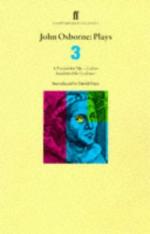|
This section contains 296 words (approx. 1 page at 400 words per page) |

|
In the early 1950s, British audiences watched imported American musicals; sentimental plots involving the middle class and their traditional, moral standards of behavior; and drawing-room comedies. The British theater offered nothing, in short, that was connected to the social and political realities of the age. Then on May 8, 1956, John Osborne brought new life to the London stage with his play Look Back in Anger, a work that focuses on the British working class and its sense of being betrayed by political and social institutions. This new type of realism urged a generation of British playwrights such as Arnold Wesker (Chicken Soup with Barley, 1958, and The Kitchen, 1959) and Edward Bond (Saved, 1965)) to recreate on stage cottages in dirty industrial towns in the north of England as well as rented one-room flats in London. In these plays that came to be known as...
|
This section contains 296 words (approx. 1 page at 400 words per page) |

|




